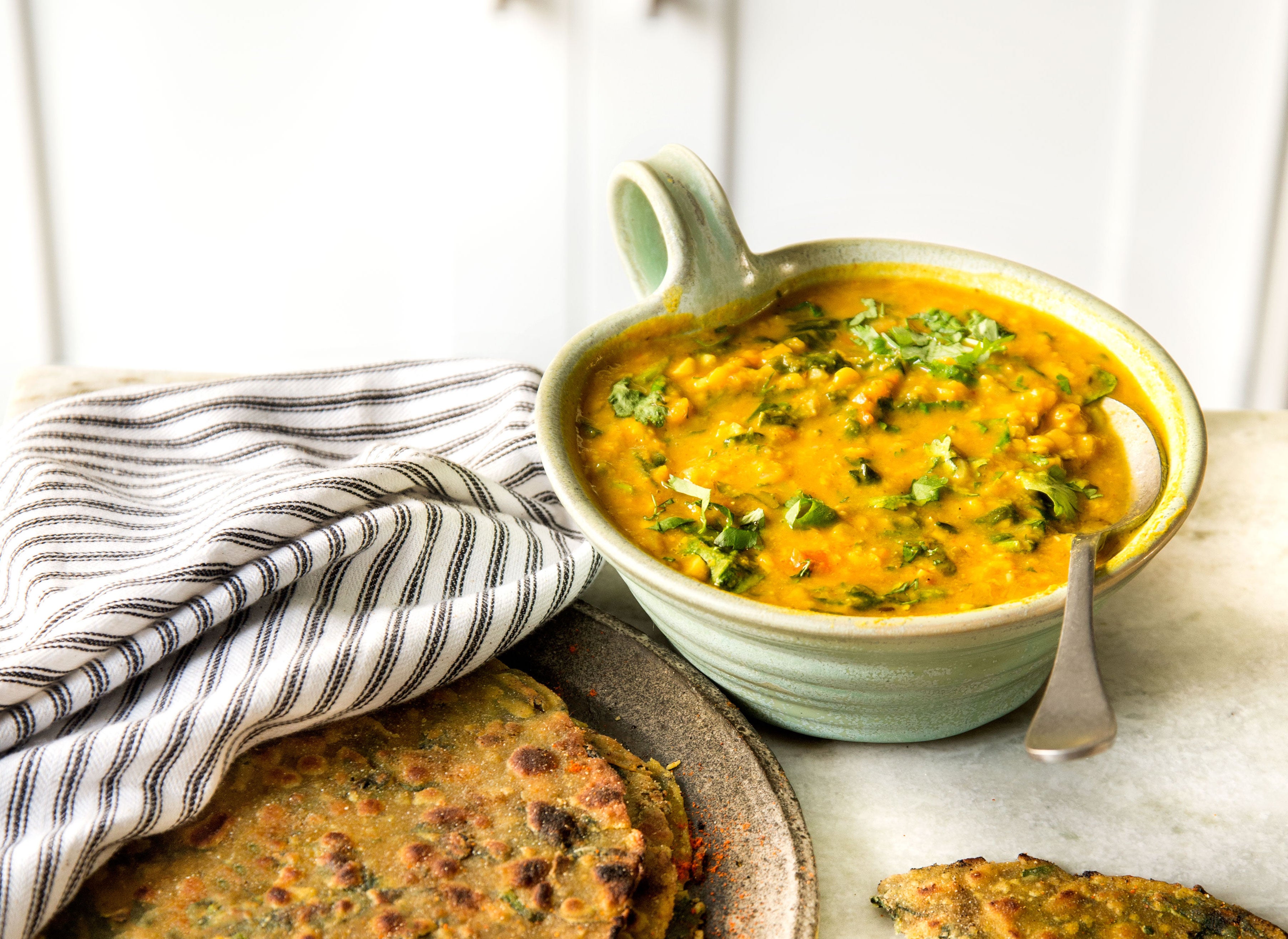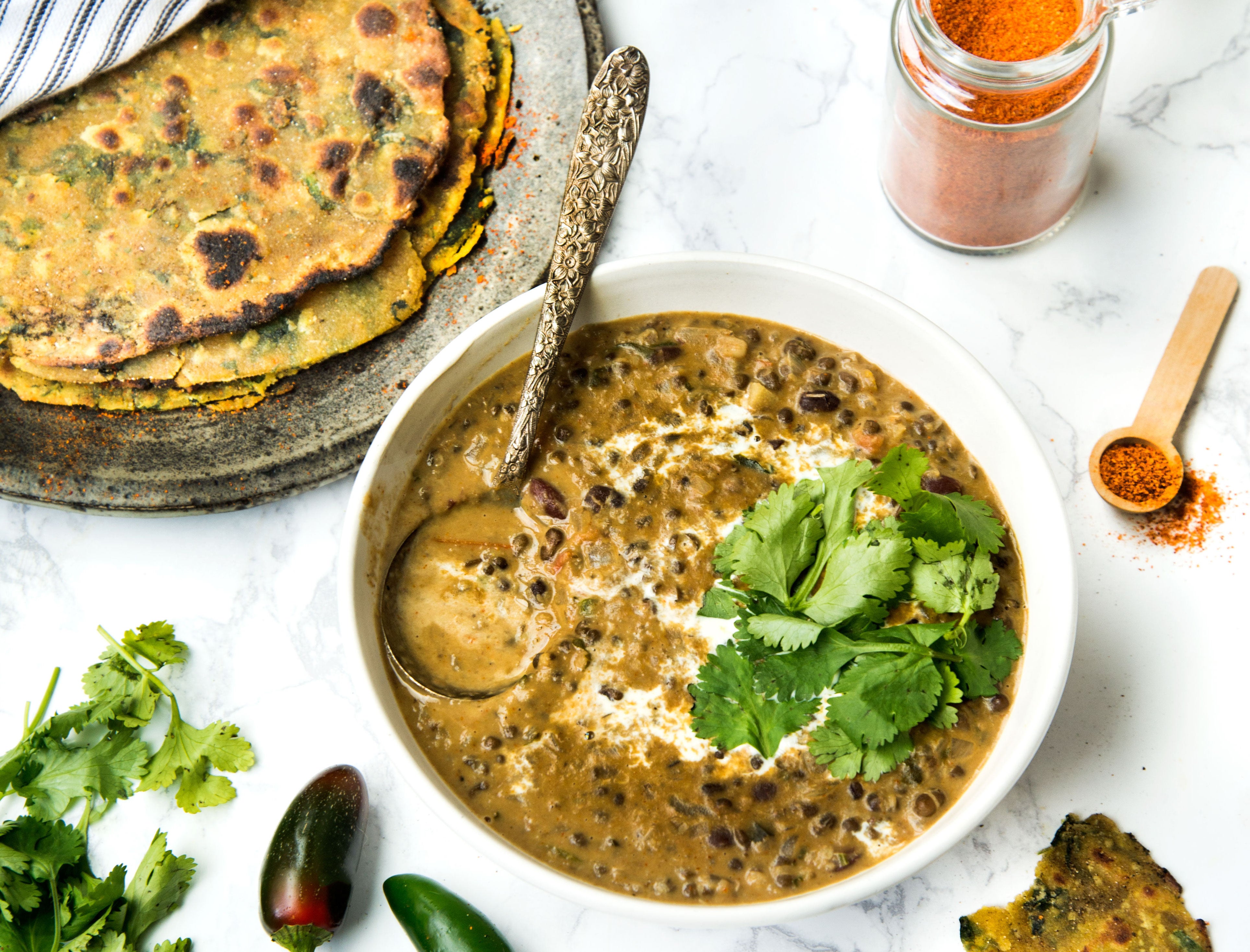What’s up with dal? A good question. In India, the term (also spelled daal, dhal, and dahl) refers to pulses (dried legumes that include beans, lentils, and peas) and is also used to refer to a stew made of said legumes. It can get a little confusing, but trust me: The confusion is worth it.
For centuries, dal has been an essential part of India’s rich culinary tradition, served at just about every meal. It’s nourishing, inexpensive, healthy, protein-rich, and, most important, harmoniously balanced when infused with herbs and spices. The variation in regional dal dishes is so vast that you could make a different dal every day and not repeat for months. Beyond soups/stews, dal can also be used in chutneys, pancakes, salads, and desserts, as well as sprouted and/or ground into flour—the options are seemingly endless.
On their own, dal are rather undistinctive. It’s the spices, herbs, and vegetables you add that pack flavor and give dal different personalities. Tadka (also referred to as tarka or chaunk), the process of tempering spices and herbs in oil/ghee, is an essential technique when preparing dal. To prepare a tadka, whole spices such as coriander, cumin, or mustard seeds are added to hot oil or ghee and cooked until they sizzle, turning reddish brown and fragrant. Next, ingredients such as onion, ginger, garlic, tomatoes, and fresh chiles are added to the hot oil. Ground spices are last, since they tend to burn easily. Finally, the tadka is added to the cooked dal, and that’s when the magic happens. The hot spices and infused oil permeate the cooked dal, producing an incredibly aromatic and flavorful dish.

Shopping for Dal
In any Indian grocery store worth its salt (in New York, my favorite is Patel Brothers), you’ll find shelf after shelf lined with dal. The choices might seem daunting at first glance, but upon closer inspection you may recognize many of them. Some of the most common dal in Indian cooking include mung beans, chickpeas, lentils, split peas, adzuki beans, kidney beans, and pigeon peas.
How to Prep
Now that you’re stocked up, it’s time to do some cooking. First off, before you cook your dal, you’ll want to sort through them for any pebbles or debris. Next, put the dal in a sieve and rinse until the water runs clear. At this point, whole beans should be soaked overnight, which makes them more digestible and speeds up cooking times. Certain dal (like those that are skinned and split in half) do not necessarily need to be soaked. Traditionally, certain Indian recipes call for the split variety versus whole. The skinned and split variety require a shorter cooking time.
The cooking time for dal will vary depending on the type of dal, its age (i.e., how long it’s been sitting on the shelf), and the hardness of your water. Old dal may take twice as long as fresh; just remember to add more water if it takes longer for the dal to cook. Hard water, which has a high mineral content, also increases cooking time.
Cooking Methods
While a pressure cooker is not essential for cooking dal, it does make the process easier and quicker (resulting in perfectly cooked dal in 20 percent of the time needed to cook dal the traditional way—that is, on the stove top). In addition to traditional pressure cookers, there are also electric pressure cookers on the market (such as the popular Instant Pot). Indian pressure cookers are a little different. They regularly release steam in what is referred to as “whistles,” and the time it takes to pressure-cook something is described according to how many whistles you hear. While I own many a cooking appliance, a pressure cooker is not among them, so I opt for the stove top method. This works well; it just takes longer.
Traditionally, cooking dal in a tandoor oven lends a smoky flavor, but you can still achieve that smoky flavor with a little piece of coal using a method known as the Dhungar technique. You simply heat a piece of coal over a flame until red hot. Then you place the hot coal in a heatproof bowl or hollowed-out onion and add that to your pot of food. Drizzle the coal with a little oil or ghee, and it will begin to smoke. Quickly cover the pot and let the smoky flavor infuse your dal.
Ingredients
- 1 cup chana dal (dried split chickpeas)
- 1 teaspoon turmeric
- 1 teaspoon salt
- 4½ cups water
- 2 tablespoons ghee
- ¾ teaspoons cumin seeds
- 1 cup finely diced onion
- 1 inch-long piece of ginger, grated
- 5-6 cloves of garlic, minced
- 1 green chile (like a serrano or jalapeño), minced
- 1 cup tomato, diced
- 1 pinch of asafetida (optional)
- ½ teaspoons garam masala
- ½ teaspoons chile powder, like Deggi Mirch
- 1 teaspoon dried fenugreek leaves (optional)
- A couple large handfuls of baby spinach
- chopped cilantro, for garnish
Palak chana dal, or Indian-spiced yellow split chickpeas with spinach, is an easy, approachable, and flavorful dal. Its porridge-like thick, creamy texture is incredibly homey, but it’s the combination of Indian spices and aromatics, fried in ghee or oil, that make this dish come alive with flavor. While you can certainly eat it with a spoon, it’s even better to tear off a hunk of roti or naan and scoop up some of the dal. A few notes on some of the more unusual ingredients: Asafetida, a spice also known as hing, may strike you as overpowering and somewhat unpleasant on its own, but as it cooks it mellows out and produces a pleasant oniony-garlicky flavor. A pinch is all you need. If you can find fresh fenugreek leaves (they can also be found frozen in many Indian grocery stores), you can add them in with the spinach. Fenugreek provides a perfumed bitterness to the dal and is often described as having a mild celery-fennel flavor.
- Sort through your beans for any pebbles or debris. Rinse under cold water three or four times.
- In a large saucepan or pot, combine the chana dal, turmeric, salt, and 4½ cups of water. Bring to a boil, then reduce the heat and simmer, partly covered, for 40 minutes (add more water if needed). The consistency should not be too thin or thick. If too thick, add more water. If too thin, simmer a little longer.
- Meanwhile, heat the ghee or oil in a skillet over medium-high heat. When hot, add the cumin seeds and fry for about 30 seconds until fragrant. Add the onion and sauté until golden, about 5 to 7 minutes. Add the ginger, garlic, and green chile and continue to sauté a minute or two until the garlic is golden but not browned. Add the tomatoes.
- Stir in the asafetida, garam masala, and chile powder. Continue to cook until the tomatoes break down and are soft.
- Stir in the dried fenugreek leaves. Then add this mixture to the pot with the chana dal.
- Bring the pot back to a simmer. Add the spinach and cook until just wilted.
- Garnish with cilantro leaves. Serve with rice, naan, paratha, or roti.
Ingredients
- ¾ cups dried whole black lentils
- ¼ cups dried adzuki and/or kidney beans
- 3 tablespoons ghee
- 1½ teaspoons cumin seeds
- 1 2-inch knob of ginger, grated
- 2 cloves garlic, grated
- 1 large onion, finely diced
- 2 medium tomatoes, diced
- 1 teaspoon chile powder (like Deggi Mirch)
- salt
- 2-3 tablespoons heavy cream (or yogurt)
- 1 teaspoon garam masala
- 1 teaspoon dried fenugreek leaves (optional)
- 2 tablespoons chopped cilantro
Dal makhani is a popular Punjabi dish made from whole black lentils (sabut urad) and red kidney beans (rajmah) and/or adzuki beans. It’s cooked with butter (makhan) and cream (malai), which gives the finished dish a smooth, creamy texture. Given the addition of butter and cream, this dish has a rich mouthfeel, with a complex combination of dried and fresh spices and herbs, with just a hint of smokiness.
- Sort through your beans for any pebbles or debris. Rinse under cold water three or four times.
- Soak the lentils and beans, 8 hours or overnight. Rinse under cold water.
- Add the soaked lentils, beans, and 5 cups of water to a pot. Bring to a boil, decrease heat to a simmer and cook until the dal are tender, about 40 to 45 minutes.
- Heat the ghee in a heavy pot. Add the cumin seeds and cook until they sizzle and become fragrant, 1 minute.
- Add the onion and sauté until golden, about 5 to 7 minutes. Add the grated ginger and garlic and cook, stirring often, 5 minutes.
- Add the tomato and chile powder and cook until the tomato becomes soft, 5 minutes.
- Add the cooked dal to the pot. Season with salt. Simmer over low heat, stirring from time to time, until thick and creamy, about 30 minutes. If the dal becomes too thick, add a little more water. To make the dal extra creamy, remove ½ cup of the dal and some of the cooking liquid and process in a blender until smooth. Add the pureed dal back to the pot.
- Mix in the cream (or yogurt). Add the garam masala and dried fenugreek leaves.
- Ladle into bowls. Garnish with cilantro. Serve with rice, naan, paratha, or roti.
Dhungar Smoking Technique
- Heat a piece of charcoal over a stove top flame, turning occasionally, until red hot, about 10 minutes.
- Place the smoldering coal in a heat-proof bowl or hollowed-out onion and place it into the finished pot of dal. Pour a little oil (or ghee) over the hot coal.
- As soon as the coal starts to smoke, cover the pot with a lid.
- Keep covered for a few minutes or up to 15 minutes. The longer you keep it covered, the smokier the food becomes.


